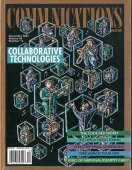December 2001 - Vol. 44 No. 12

Features
Revolutionizing the Traditional Classroom Course
Operating an Emergency Information Service
The Growing Debate Over Science and Technology Advice For Congress
Toward Virtual Marketplaces For E-Commerce Support
Collaborative Virtual Design Environments: Introduction
Design Engineering in Virtual Environments
Collaborative Virtual Environments For Analysis and Decision Support
Expert Finding For Collaborative Virtual Environments
A Shared Virtual Environment For Exploring and Designing Molecules
Collaborative Shape Conceptualization in Virtual Design Environments
3D Animation of Telecollaborative Anthropomorphic Avatars
Global Applications of Collaborative Technology: Introduction
The Myth of the Boundaryless Organization
Groupware and the Social Infrastructure of Communication
Building A Global Learning Community
Cultural Perceptions of Task-Technology Fit
Paradoxes and Prerogatives in Global Virtual Collaboration
Nonconsensual Negotiation in Distributed Collaboration
Admediation: New Horizons in Effective Email Advertising
Internet Publishing and Transformation of Knowledge Processes
Risks of National Identity Cards



